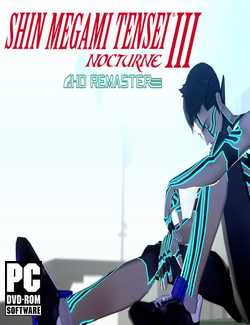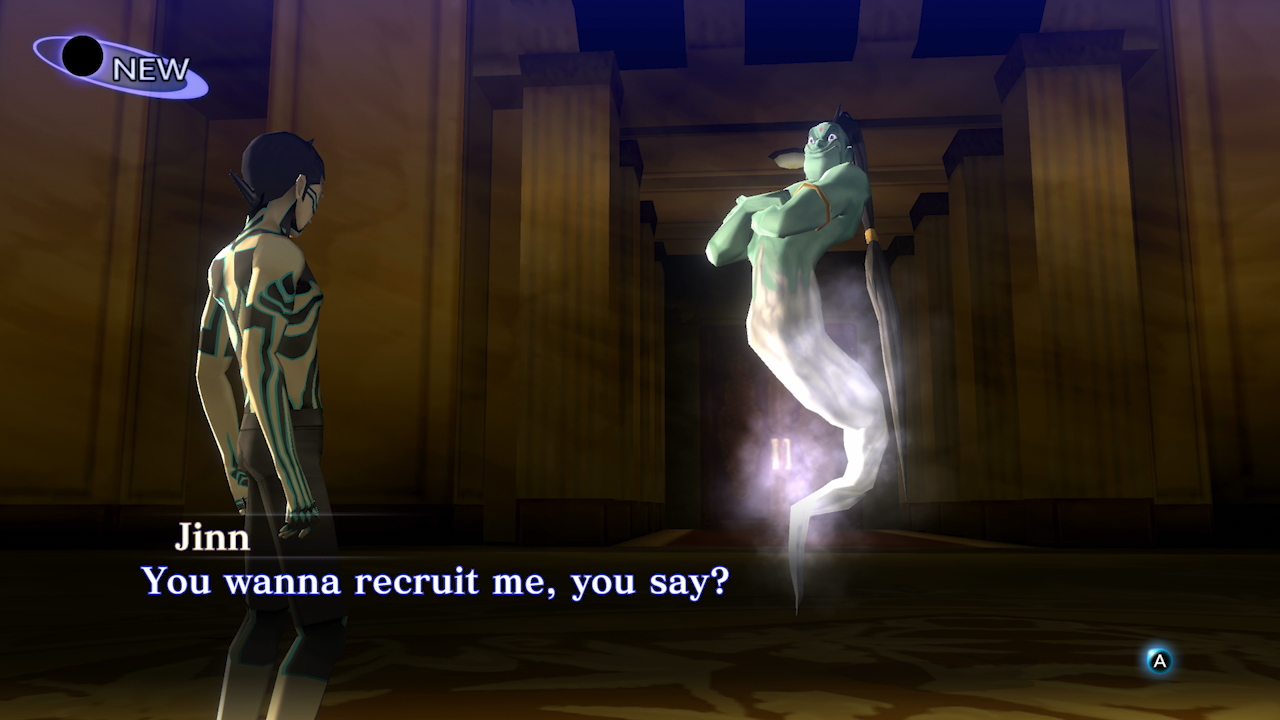Search
[{{{type}}}] {{{reason}}}
{{/data.error.root_cause}}{{{_source.title}}} {{#_source.showPrice}} {{{_source.displayPrice}}} {{/_source.showPrice}}
{{#_source.showLink}} {{/_source.showLink}} {{#_source.showDate}}{{{_source.displayDate}}}
{{/_source.showDate}}{{{_source.description}}}
{{#_source.additionalInfo}}{{#_source.additionalFields}} {{#title}} {{{label}}}: {{{title}}} {{/title}} {{/_source.additionalFields}}
{{/_source.additionalInfo}}- Details
- Category: Computer
- By Daniel Cullen
- Hits: 4201
Shin Megami Tensei III Nocturne HD Remaster (PC)

Shin Megami Tensei III Nocturne HD Remaster
Developed By: Atlus
Published By: Sega
Released: May 24, 2021
Available On: Microsoft Windows, Nintendo Switch, PlayStation 4
Genre: Turn-Based RPG
ESRB Rating: Mature
Number of Players: Singleplayer
Price: $49.99
(Humble Store Link)
I'd like to thank Sega for the review key for this title.
As Jesus said in the Book of Luke, no one uses an old wineskin for storing wine, lest the wineskin break. Atlus, paying heed to this advice, realized Shin Megami Tensei III Nocturne was perfectly good as a game, but its engine and presentation needed a severe update. Accordingly, they made Shin Megami Tensei III Nocturne HD Remaster.
Shin Megami Tensei III Nocturne HD Remaster is called a remaster, but it's more an engine remake, presentation remaster, and otherwise compilation of the original release, the Manaix international release (which English players got to play, with Dante from Devil May Cry), and the Chronicles third edition which was Japanese only (that switched out Dante for SMT protagonist Raidou Kunuzoha). As result, we get an engine that was ported and rewritten in modern-day Unity, quality of life and graphical improvements to all the in-game content, and the choice of playing the game as intended for each of its official releases.
The story is that a doomsday cult has summoned a being to revert the world to a primordial state so it can be reformed according to their wishes. Others have competing ideas about how the world should be reformed, and Lucifer is working in the background with a different agenda, offering you aid regardless of your choices. Further, depending on your actions, your decisions regarding the reshaping of the world could lead to consequences that span universes.
The gameplay is essentially a turn-based RPG with demons as summonable and recruitable party members. Demons can gain levels, albeit slowly, and there is also "Mitama fusion", where demons called Mitamas can be fused to your demons to increase their stats without changing them into another demon. A "moon phase" mechanic exists, with some attacks affected by the current phase as well as random treasures and demon recruitment. Demon fusion is far less tedious than it would be otherwise due to a compendium to keep track of previously recruited/summoned demons.
Other mechanics revolve around your main character. They can learn new skills via the aid of equipable accessories called Magatama, and customizing your character is integral to many winning strategies. The combat has the "Press Turn" system, where hitting weaknesses of enemies can award bonus turns, and hitting strengths can remove them, a system that works for both friend and foe and involves careful strategy to use to get its full benefit. Some quality of life enhancements now exists due to being rewritten for the Unity Engine, such as the ability to manually choose inheritable skills on level-ups for your demon party members.

Strong Points: Excellent engine rewrite with quality of life improvements
Weak Points: High price for a remaster of a PS2 game
Moral Warnings: RPG-like violence; displays of blood; frequent profanity (b**t**d, a**, s**t); occasional sexual innuendo from a few characters; flagrant display of occult and supernatural themes (such as demon summoning) as part of the gameplay and plot; frequent blasphemy (to the point of being able to choose to rebel against the real God); options to make many unethical choices; world setting in which all religions and myths are presumed true and exist simultaneously
The graphics are a cel-shaded and polygonal combination of a haunting, otherworldly style with lots of neon-like lines. The game supports higher resolutions (up to 1920 x 1080 supported), and the speaking characters have appropriate mouth flaps to sync with the spoken dialogue. The original videos from the PS2 version are retained in 4:3 resolution, with letterboxing.
The sound effects and music focus on rock and instrumental music, along with some techno and gothic aural inspiration. Sound effects even include voice acting to not only the major characters, but they also gave many minor ones voiced line. Voice acting can be toggled between English and Japanese voices at any time.
Controls are third-person style in the overworld and combat, with the camera set somewhat behind your character, providing plenty of room to navigate and move around comfortably. There is an alternative first-person style view, but it's mostly for aesthetics. Controls now fully support a keyboard and mouse along with gamepads. Both are quite responsive. I did have trouble using a generic gamepad, as the game refused to recognize it as a valid controller, though it does respond well to Xbox-style controllers and other official controllers compatible with Steam. Both styles of play can be fully remapped and several basic configurations are provided for player comfort and ease of use.
Stability is excellent due to porting to the Unity engine. Aside from a few minor light flicker issues at times, the frame rate is very smooth, though locked at 30 FPS at all times. This appears to be done to keep scene transitions stable on all platforms and to prevent hitches in the frame rate.
I was able to get this game working in Linux via Proton on the latest builds, though videos do not work (but will not crash the game, they display an error window that can be toggled past; video failure is common in Proton). The game is otherwise playable like on Windows but may suffer some frame rate hitches.
Most players will have access to the base game and the free Chronicles DLC with Raidou Kunozoha and the content that entails, though players with the Maniax DLC will get the Dante-specific content from that version (with Reuben Langdon voicing Dante's lines). Sega included all the DLC in their review key which extends the basic game, and I shall cover each in brief:
Merciful Mode (Free): A new Easy Difficulty that makes the game drastically easier.
BGM Nostalgia (Paid): Replace the overworld theme and battle BGM with music from other SMT titles.
Maniax Mode (Paid): Allows a game playthrough with Dante from Devil May Cry along with Labyrinth of Amala content, Raidou is disabled.
Chronicles Mode (Free): Allows a game playthrough with Raidou along with Labyrinth of Amala content, Dante is disabled.
Mercy and Expectations Maps (Paid): Maps where items that drop EXP and Macca boosters are added to the Amala Network.
Morally, this game has definite issues.
Violence is of the RPG variety and is rendered in a rather sanitized style due to the cel-shading motif in the turn-based combat segments. There are some depictions of humanoid beings whose bodies are left lying around with blood-like pools, despite them being described in-game as not being traditionally alive and made of non-human materials.

Higher is better
(10/10 is perfect)
Game Score - 92%
Gameplay - 18/20
Graphics - 9/10
Sound - 9/10
Stability - 5/5
Controls - 5/5
Morality Score - 24%
Violence - 3/10
Language - 3/10
Sexual Content - 6/10
Occult/Supernatural - 0/10
Cultural/Moral/Ethical - 0/10
Language is rather crass, and this remaster uses PG-13 (b**t**d, a**, s**t) more frequently than even the original release did. This is typically assigned to the more foul and brutal characters to further highlight their lack of civilization and morality. Due to voice acting, this is also voiced as well as written. Any blasphemy against God is done by demons generally, as they have an obvious ax to grind. Some of the profanity comes off as excessive, often replacing dialogue that had none and got across the same points in the original game.
Sexual content is somewhat low in tone due to the art style leaving less detailing for many female characters, and there are some scantily-clad demons and some that resemble certain genitalia. References to sexual acts are sparse at best, mostly confined to the incubus/succubus-like demons, and then it's still more innuendo than anything else.
Occult and supernatural influences are profound in this game, being what caused the game to occur (though not depicted positively despite it). Some demons make a point of playing up occult imagery, and YOU are half demonic (albeit not by choice) and can summon demons as a consequence.
The ethical and moral deserves some detailed explanation because the game has several endings depending on whom you side with; those sides are referred to as "Reasons", implemented by a being named Kagutsuchi who is assumed to be "God" by most characters.
Shijima: The "Law" Ending, where the world is reformed into one of order and stillness. It's somewhat hypocritical, founded by someone who broke all the laws of Law itself and consorted with demons in defiance of God to create it. Ironically, the twisted parody of God generally approves of this world reformation choice the most, which should be a blatant clue to most Christians this is not how the real God would approve of things.
Musubi: The "Neutral" Ending, a world where everyone is free from the influence of anyone else and cannot interfere with anyone else. This world is also created by a hypocrite who required breaking their own rules to create their ideal world.
Yosuga: The "Chaos" Ending, a world based on strength. It too is hypocrisy, being founded by angels (many of which are in league with the brutal and explicitly declared evil leader of this ideology). They form a demented form of order despite it being an ideology nominally based on freedom. It's an ending stating "Law and Chaos aren't all that different if you are hypocritical about their foundation and rules". Kagutsuchi will approve of this world reformation choice as well, which is another hint if you are Christian especially that this is a perversion of God's Will.
Demon: This ending involves rejecting all other Reasons, choosing to leave the world in its primordial and chaotic state. Lucifer will approve of this choice, and Kagutsuchi will not.
Freedom: The "best" ending, in which you choose to return the world to the way it was before anyone meddled with it. It's implied your character still retains their half-demonic powers, which Lucifer encourages you to keep, but otherwise is the least morally objectionable of the endings. See below spoiler for more information:
True Demon: Christians will be appalled at this ending. In this ending, you deliberately choose to cast your lot with Lucifer and his plans, which not only involve destroying Kagutsuchi but also defeating the being known as the Great Will, who is the ACTUAL God, not just some demented rogue avatar parody version, and the ending has you agree to be Lucifer's leading general in an attempt to defeat the real God (though the game ends before we see the results of this decision)
In terms of technical improvements, this remaster is a worthy one. Morally, it's somewhat crude and disturbing due to high amounts of profanity and the scenes of violence, not to mention the omnipresent demonic and occult themes. While I recommend this title, it is rather expensive, so buying it on sale is recommended, yet I'd only recommend this title to mature adults like the original release due to its themes.




